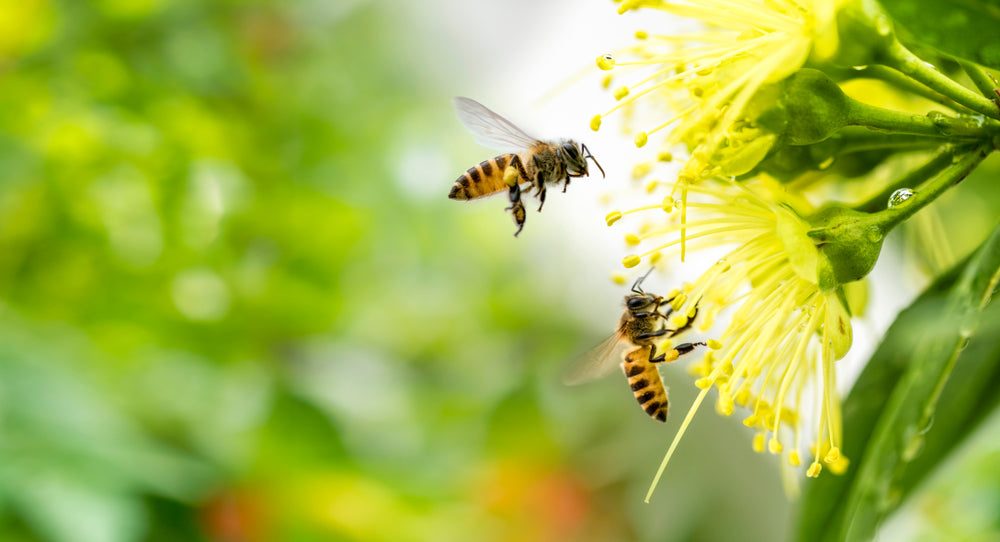Your Cart is Empty
Fuzzy and buzzy, there are almost 20,000 different species of bee in the world. Each and everyone is a guardian of biodiversity and their ecosystem. Here are seven buzzing bee facts.
Without bees, the world would be entirely different.
When a single bee lands on a flower, it touches a dustlike substance on the flower called pollen. When it flies around, it spreads this pollen from flower to flower. This process called pollination is how flowers create seeds that grow into other flowers.
Bees pollinate a third of everything we eat – and up to 170,000 species of plants! It's important that bees pollinate or we’d struggle to get nutritious food we all need to stay healthy. Like the almonds for instance. When pollinated by bees, almond trees bear more fruit, and the nuts have remarkably more Vitamin E. In America, bumblebees visit more blueberry flowers per minute than other pollinators.
Strawberries get the same love from bees! A fully developed strawberry needs around 21 visits from bees. Research also shows that bees are crucial in pollinating cucumbers, pumpkins, onions, and apples. And of course, the naughtier stuff: coffee and chocolate.

To make 1 kg of honey, a bee would have to visit four million flowers and fly the equivalent of three times around the world! Can you believe it? We’re exhausted at the thought! So when you next tuck into a spoonful of honey, think about how busy your buzzy friends have been to make it!
During the winter, honeybees all huddle together to stay warm. They live off the honey they made and stored throughout the year. Eating it keeps them warm – that’s why they make it! One honeybee produces one-twelfth of a teaspoon of honey in its lifetime. When it gets to the summer, over 80,000 bees could be living under one roof! It sounds a bit crammed!

Ancient Egyptians valued bees highly. They believed that when their sun god Ra wept, his tears turned into honeybees – and that’s where bees came from. They used honey to sweeten their food and as medicine to treat cuts and burns. They also used beeswax in their paintings and to keep the curls in place on their wigs! But their hives were very different from ours. They created theirs from horizontal tubes made of dried mud, stacked on top of each other.
Some plants spike their nectar with addictive drugs to lure insects into spreading their pollen. Studies have revealed that bees fall victim to these tricks and enjoy drinking caffeine.
Researchers found that a memory formed for the odour that came with the caffeine, which the bees loved. Compared to bees who hadn’t been treated to caffeine, three times as many bees remembered the scent and stuck out their tongues for the caffeine reward 24 hours later, and twice as many recalled it 72 hours later. So a cup of coffee doesn't just give energy to people in the morning, but bees, too!

It’s no joke. Honeybees perform the "waggle dance" to communicate to other bees where to find food. A long slow dance means that food is far away and/or is poor quality. Short fast dances mean the food is close by.
And here’s one not so great fact:
Since 1900, the UK has lost 13 species of bee, and a further 35 species are considered under threat of extinction. None is protected by law. Across Europe, nearly one in every ten wild bee species faces extinction. Changes in the way we use our land, loss of their habitats, increased use of pesticides, and climate change are a few of their battles. They’ve lost much of their natural habitat in the past 60 years – including 97% of wildflower-rich meadows.
No matter the size of your outdoor space, growing flowering plants is an effective way to help Britain’s bees and other pollinating insects. Aim for bee-friendly plants, such as honeysuckle, crocuses, and strawberries. Short of space? Try marjoram, thyme, chives, sage, or creeping rosemary in a pot. If you have more space in a sunny border, try a rosemary shrub.
Ask your parents to buy organic fruit and vegetables– this means no harmful chemicals have been used to grow your food.
Create a bee hotel. Find out how here.
Give them a drink. Water is essential for honeybees to make food and keep cool. Fill a tray with rain and put in a few large, stable stones to give bees a safe place to drink from. If you’ve already got a pond, add floating-leaved plants, wine corks, or rocks to give bees somewhere to land.
Submit a bee sighting.Your sightings will help scientists get a better understanding of how bee populations are doing and what they need to protect. Use the Blooms for Bees citizen science app to survey which flowers in your garden or allotment the bumblebees are visiting. The app and website include a handy ID guide to UK bumblebee species, too.
Comments will be approved before showing up.
Our Animal Besties writing contest from 'Nature's Best Buddies' issue brought in a flood of heartwarming, imaginative and often hilarious tales of unexpected friendships. From swans befriending capybaras to chickens bonding with foxes, your entries were full of surprise, kindness and creativity. A h...
January’s JAWsome Creatures competition brought some of the most imaginative and fearsome designs we've ever seen! From predators with sabre-like teeth to extraordinary beaks with unique feeding tricks, your entries were truly jaw-dropping. A huge thank you to everyone who took part – we loved seeing your wild and wonderful creations!
The Wildlife Photographer of the Year competition, produced by the Natural History Museum, never fails to amaze, and 2024 was no exception. Thousands of incredible images were submitted, but only a few made it to the People’s Choice Award.



